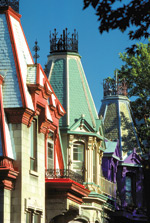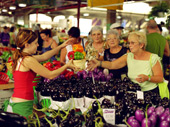With its strong French heritage, Montreal is a convenient and affordable way to get a charming touch of European flair close to the United States.
“It is European without jet lag and the euro,” said Isabelle Cyr, manager of the North American leisure market for Tourism Montreal.
More than half Montreal’s 3.6 million inhabitants speak French and English, and the narrow, brick-paved streets and three-story fieldstone buildings in Old Montreal could be straight out of a small French town.
Cyr said one of the great experiences for Americans in visiting Montreal is the “shock of the language, just hearing people with funny accents like mine.”
One of the oldest cities in North America, Montreal is also a vibrant modern city with an active nightlife and fun-loving citizens who flock to numerous festivals and special events throughout the year.
“Montreal is a big city on a human scale; people take time to live. It is a mix of American drive with joie de vivre of the French,” said one of the many registered professional guides who are available to show groups around the city.
“It is still really affordable compared with big American cities,” said Cyr. “It is an amazing getaway for not that much money.”
Getting started
The best place to start a visit to Montreal is in Old Montreal, a 95-acre neighborhood where a small group of French colonists led by Paul de Chomedey, Sieur de Maisonneuve, founded the city, then known as Villa Marie, in 1642.
Today, the area, which benefited from a vigorous restoration movement in the 1960s, is filled with museums, shops, galleries, restaurants, bistros and outdoor cafes, many located in 18th- and 19th-century buildings.
|
More than meat and potatoes Before Expo 67, Montreal was a meat-and-potatoes city, according to Isabelle Cyr, manager of the North American leisure market for Tourism Montreal. “From a culinary aspect, the World’s Fair really changed things,” said Cyr. “We had all those chefs from all over the world, and a lot of them fell in love with the city and stayed over and slowly started changing the trends in eating.” Things so changed that in 2007 Montreal was one of 15 cities to join the prestigious World Good Food Cities Network. Montreal’s growing number of ethnic neighborhoods also helped, and today there are more than 80 different kinds of food served in more than 6,000 restaurants, one of the largest number of restaurants per capita in North America. Montreal’s varied, tasty and affordable culinary scene is something Cyr has been pushing with leisure groups. “It is really multicultural with a big European feel for the importance of cooking, good wine and taking the time to eat,” she said. “And upscale food doesn’t mean high price. You can have an excellent meal for a really affordable price.” Another part of the Montreal’s culinary scene is its bustling public markets. “Something really unique in this aspect is the markets. They are a nice culinary experience, and you can also mix with the locals,” said Cyr. Packed with fresh seasonal produce, meat, cheeses and more, the markets are filled with activity year round. Three of the more popular ones with visitors are the Jean-Talon Market in Little Italy, the art deco Atwater Market on the shores of the Lachine Canal and the Maisonneuve Market, located in a beaux-arts-style building near the Olympic Stadium. The largest, Atwater Market, has more than 25 stores inside and more than 100 stalls outside. It is especially known for meat, with more than a half-dozen butchers. “There are some nice little cooking schools around the Jean-Talon Market,” said Cyr. “They go to the market with the chef, buy what they need, go back to school and do it themselves and then eat what they prepared.” Visites de Montreal, a local tour guide and event-planning company, has a popular new 90-minute tour of Old Montreal that includes four stops to taste food. |
A statue of Masionneuve stands in the Place de Armes near the distinctive clock tower of the 324-year-old Sulpician Seminary, the oldest building in Montreal.
The Place de Armes is also the location of the Basilica of Notre Dame, a magnificent mid-18th-century structure whose mostly wooden interior took more than 40 years to complete.
“Just as coming to Montreal without seeing Old Montreal is a shame, going to Old Montreal without seeing Notre Dame is a shame,” said Cyr. “Its history is directly linked to the history of Montreal. The first ones who settled wanted to evangelize the natives.
“Inside it is an amazing church with all painted wood.”
Cyr said a moving way to see the church is during its evening light-and-sound show.
“They start lighting different parts of the basilica, and it is even more impressive with the organ playing in the back. It is a huge organ, with more than 500 pipes, you feel the vibration,” she said.
“It is really emotional. I have seen it many times, and I become emotional each time I see it. It really is a must.”
Another interesting church in Old Montreal is Notre Dame de Bonsecourts, which is known as the sailor’s church because of the many seaman who prayed there and left votive offerings in the form of model ships that hang from the church’s rafters.
Although the French ruled Montreal for more than 120 years, most of the buildings in Old Montreal date from after the English takeover in 1763. One building that dates from the French period is the Chateau Ramezay, built in 1705 for the French governor and later used by the English governor. It is now a museum of period furniture.
Although its narrow streets limit motorcoach access, Cyr said that is not a problem, since the best way to experience Old Montreal is by walking.
“It really is about discovering it by foot,” said Cyr. “It is safe and not that big. You get a flair for it, and there is lots of people watching to do.”
One of the great places to watch people is from one of the sidewalk cafes at Place Jacques Cartier, the heart of Old Montreal, which extends from the 1878 City Hall to the renovated Old Port area and is often filled with street performers.
Leaving their mark
Just as early French settlers influenced Montreal, two 20th-century events left indelible architectural legacies.
The geodesic dome that housed the United States pavilion during Montreal’s highly successful 1967 world’s fair, Expo 67, is now home to the Biosphere, an interactive museum devoted to the world’s water resources.
Nearby, the modernistic French and Quebec pavilions now house the Casino de Montreal, a clean and bright facility that has more than 3,000 slot machines and 120 gaming tables.
The spaceship-like structure of the domed Olympic Stadium was a focal point of the 1976 summer Olympics held in Montreal. Funicular cars take visitors to the top of the stadium’s adjoining tower for sweeping views of Montreal’s skyline.
In the early 1990s, the structure that was built for the cycling competition during the Olympics was converted to the Biodome, which authentically re-creates four different ecosystems — the tropical forest of Costa Rica, the Laurentian forest of northern Quebec, the St. Lawrence marine system and the northern and southern polar worlds.
 |
| By Pierre St.-Jacques, courtesy Tourism Canada |
The realistic environments are complete with animals, from tropical birds to penguins.
“Groups can get behind-the-scenes tours of the Biodome to see how they re-created those ecosystems and how they feed those different animals,” said Cyr.
Within walking distance of Olympic Stadium is Montreal’s Botanical Garden with more than 30 theme gardens. “It is considered the second-largest in the world after the Kew Gardens in England, not so much for its size but its diversity,” said Cyr.
“It has an amazing Chinese garden, which has another nighttime activity in the fall from September until the beginning of November. The Magic of the Lanterns features 10,000 Chinese lanterns, all lit at night. It is something not to be missed with groups,” she said.
Old and new
Montreal comfortably mixes its old and new. No where is that combination of old and new more evident than at another of Cyr’s must-see places, the Pointe-à-Callière, Montreal Museum of Archaeology and History in Old Montreal, where a triangular modernistic building gracefully sits over the city’s first Catholic cemetery.
A multimedia light show tells the history of Montreal as visitors sit in balconies overlooking the ruins of the cemetery.
The building connects to the renovated Old Custom House, where exhibits deal with life in Montreal during the 19th and 20th centuries, while in the lower level is archaeological work from the earliest fortifications to the 20th century.
“You really get to understand how Montreal started,” said Cyr.
Neighborhoods
A charming and easily walked aspect of Montreal is its neighborhoods.
“The smaller neighborhoods have become more attractive to tourists,” said Cyr.
Several neighborhoods within walking distance of downtown have brightly painted Victorian row houses with distinctive exterior staircases and balconies.
Little Italy is representative of Montreal’s great cultural diversity, with more than 80 different ethnic communities. “That is something people do not expect,” said Cyr.
Plateau Mont-Royal, one of the older neighborhoods, is a predominantly francophone community with a large concentration of artists, funky shops, bistros, cafes, theaters and galleries.
Plateau Mont-Royal is in the eastern shadow of Mount Royal, the most dominant physical feature in Montreal. A city ordinance prohibits any building from being taller than the 760-foot peak.
| Researching your trip |
| Tourism Montreal Isabelle Cyr Manager, leisure market, North America www.tourisme-montreal.org (514) 844-2075 |
“We don’t want to make it look short,” said Cyr. “It’s a little hill, but a mountain for all Montreal. We say, ‘I went to the mountain.’”
Montreal visitors can say they have been to the mountain and to Europe.











